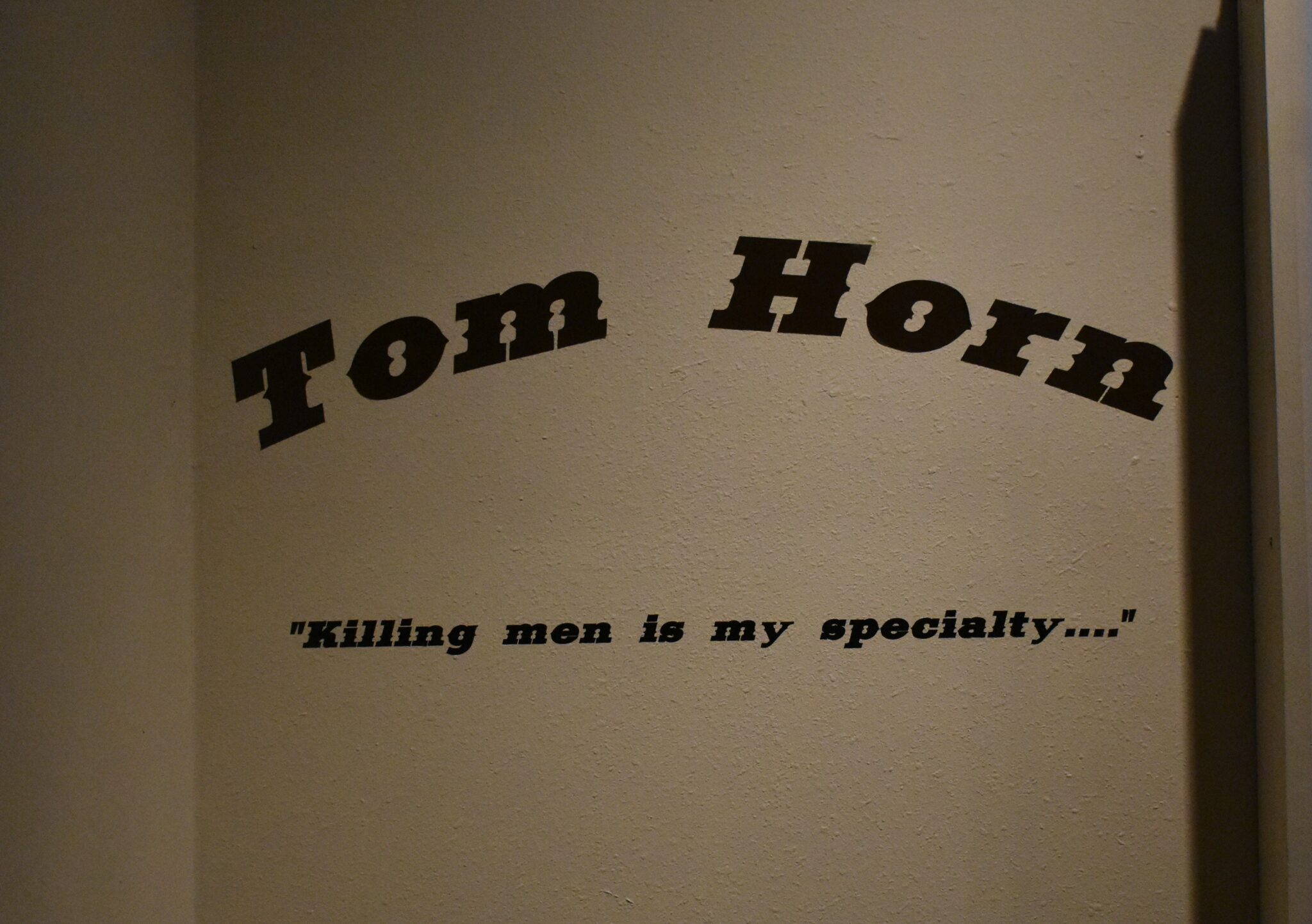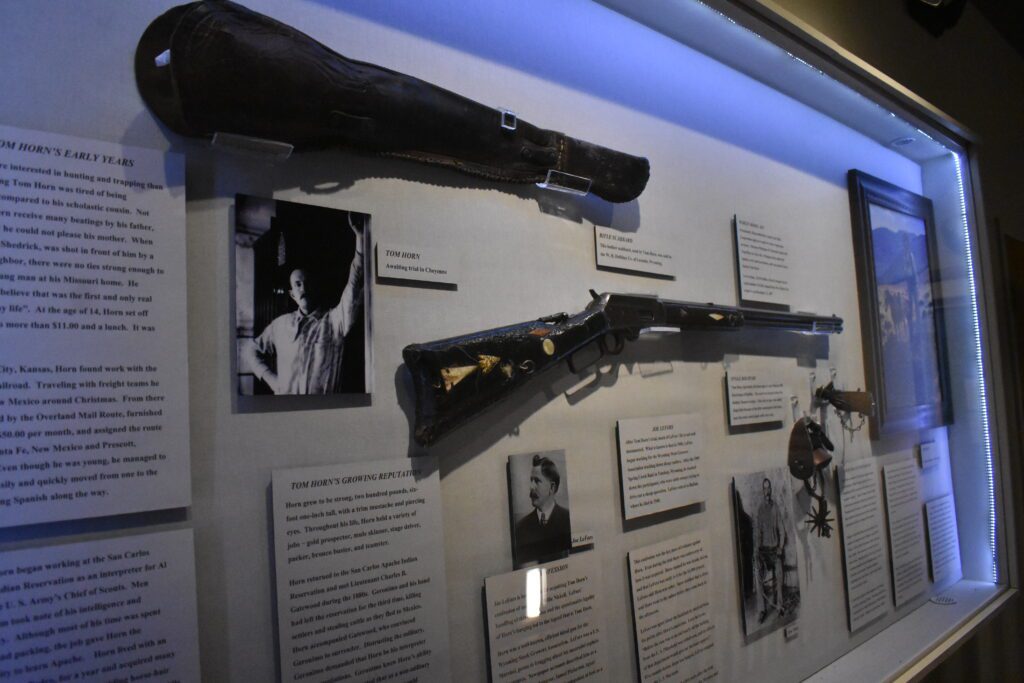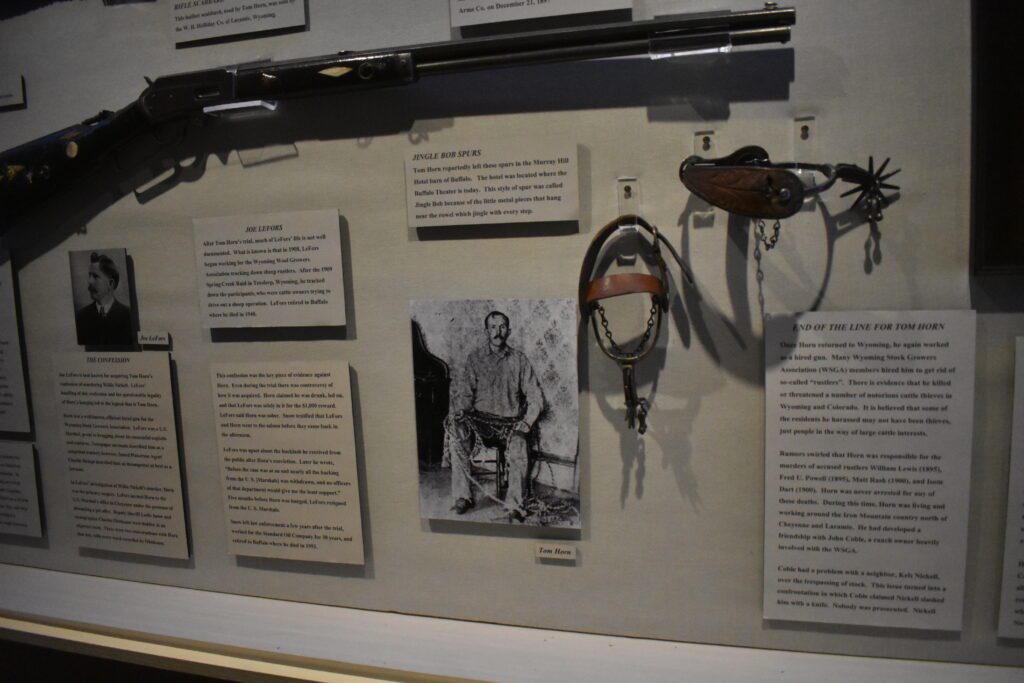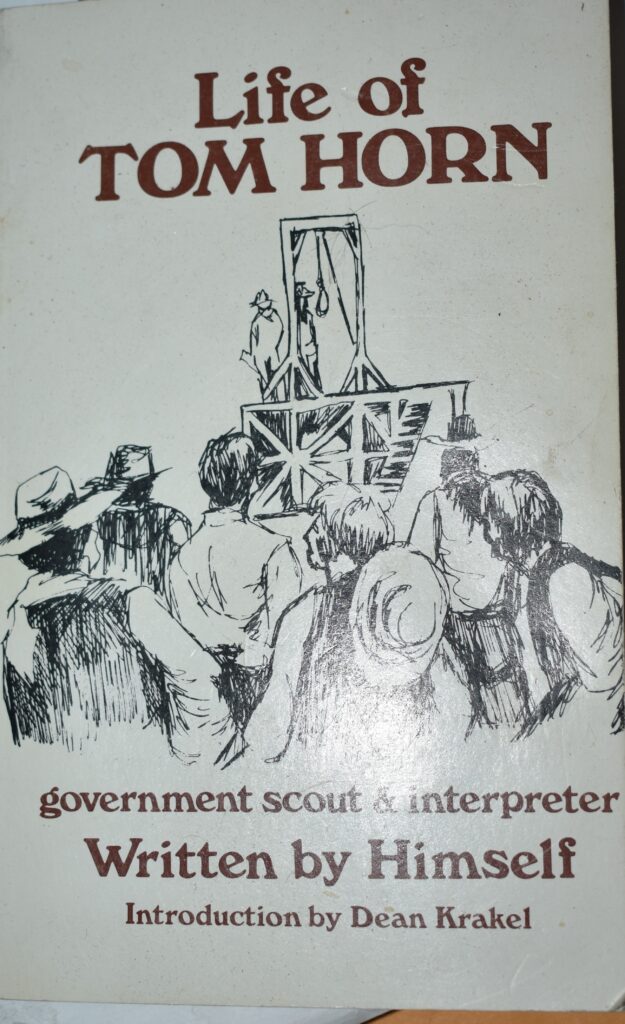News
Tom Horn, the Killing of Willie Nickell

Jim Gatchell Memorial Museum Display
Tom Horn, hired killer or range detective, was convicted in 1902 for the murder of 14-year-old Willie Nickell near Iron Mountain Wyoming.
This from The Wyoming Industrial Journal, September 1, 1901 – It is asserted that band of sheep was the cause of the death of Willie Nickell, the 14-year-old son of Kels P. Nickell, the Iron Mountain ranchman, who was assassinated near his father’s ranch a month ago, and the shooting of the elder Nickell. The sheep were grazed in the Iron Mountain country against the wishes of certain cattlemen, who claim the section for cattle by reason of prior settlement; but this did not warrant murder, and especially the killing of an innocent boy. The time for this sort of thing is past and steps should at once be taken to put stop to the murderous practices. Laramie County has been disgraced time and again in similar manner and the question arises, What are we going to do about it? It seems to us that these range disputes could be settled without resorting to arms or the killing of innocent boys. Cattle- and sheep-men should get together, discuss their differences, make concessions and settle these vexatious disputes in a friendly manner.

Jim Gatchell Memorial Museum Display
Tom Horn was arrested for the murder and brought to trial.
This from The Weekly Boomerang, Laramie, Wyoming, January 14, 1902. – Arrest Of Tom Horn, Detective- Tom Horn is under arrest, charged with the murder of Willie Nickell, says the Cheyenne Leader. This was the startling news passed from mouth to mouth on the streets of the city yesterday afternoon and created almost as great excitement as did the foul murder of Willie Nickell six months ago.
Took His Gun Away – The arrest was made by Sheriff E. J. Smalley and Deputy Sheriff Richard Proctor in the office of the Inter Ocean hotel at 11:30 o’clock yesterday morning. It is not known whether the officers expected Horn would resist arrest or not but no chances were taken and the arrest, was conducted in such a manner that Horn was disarmed before he realized the purpose of the officers. Smalley walked up to the detective, who was sitting on one of the lounges in the office and reaching out his hand said.
“Good morning, Tom,” Horn promptly grabbed the outstretched hand and at the same time Smalley by a quick move relieved Horn of his revolver, which was sticking down inside his pants. It was all over so quickly no one present realized what had been done. “I have a warrant for your arrest,” remarked Smalley. after sticking Horn’s gun into his own pocket.
“What! What is the charge?” asked the detective. “Murder,” was the laconic and somewhat startling reply. “All right,” replied the detective, and rose to his feet and accompanied by the officers to the county jail without demurring.
He was incarcerated in the jail and there must remain until the termination of the trial which will determine his guilt or innocence, as murder is not a bailable offense. The officers are non-committal regarding the details of the affair, but Sheriff Smalley stated that the authorities had a strong case against the prisoner. What the evidence is upon which the prosecution relies cannot be obtained and the officers stare nothing will be made public until the trial.
The murder of Willie Nickell occurred about 6 o’clock on the morning of July 18th of last year, on the ranch of his father near Iron Mountain. The boy was but fifteen years of age and went on horseback to drive some cattle from one pasture to another and was shot about a mile from his home near a gate leading from the pasture to the highroad. The body was not found until several hours later.
Two days before the killing on July 16th, Tom Horn, who is employed as a cattle detective, was at the Miller ranch on the morning of July 17th one day before the murder occurred. From that time nothing was seen of him for several days, when he turned up at the Coble ranch, and in answer to a subpoena, came to Cheyenne and testified before the coroner’s jury regarding the case. There was no direct evidence obtained against him at the time, and hence his arrest now comes in the form of a surprise. The trial of the case will no doubt bring out several sensational developments.
Sheriff Joe LeFors was credited as the officer who obtained the confession from Horn. Some newspaper reports from the time said that LeFors ‘trapped’ Horn into confessing to the murder.

Jim Gatchell Memorial Museum Display
This from The Sheridan Post, January 30, 1902 – Noted Cattle Detective Admitted to Joe LeFors that He Killed Willie Nickell at Iron Mountain. LeFors told Him He Knew of All the Killings and Wormed a Confession from Him. – Tom Horn, charged with the murder of Willie Nickell at Iron Mountain July 18, 1901, was given a preliminary hearing before Judge Becker, at Cheyenne, last Thursday. The prosecution sprung a surprise when they put Joe LeFors, Deputy United States Marshal, on the stand. He told of having succeeded in getting Tom Horn to come from Denver to Cheyenne so that they might arrange the details of a job LeFors was getting for Horn in Montana. While talking over this matter LeFors wormed from the murderer a confession, not only of the killing of Willie Nickell, but of Powell and Lewis, in the vicinity of Iron Mountain, in 1895. Two witnesses who had been secreted in an adjoining room heard the conversation, and one of them took it down in shorthand. The trap was well set, and the victim walked right into it.
Following is part of the testimony brought out by the cross-examination of LeFors: A. We had conversation about various things, mostly about killing people: among them was an instance spoken of where he killed a lieutenant in the army in Old Mexico at a dance.
After this conversation state whether or not you asked him how much he got for killing these people? A. I asked him how much he usually got for killing these people. I says, Tom, in the Powell and Lewis killing you got $600 apiece: you killed Lewis in a corral with a six shooter: He says how did you know that? I says, Tom, I have known everything that you have done for a good many years: I says you were paid this money between Cheyenne and Denver: you were paid two one hundred dollar bills the rest in gold, wasn’t you? He said yes. He says there is where I learned to take care of my shells; in killing Lewis I afterwards flashed powder in live 46-90 shells and left them on my trail and the G d — officers never found them.
Q. State what if anything further was said with relation to the amount he got for killing Willie Nickell A. I says, Tom, you got $500 for that job, why did you cut the price. A. He says, I got $2100.00 for killing three men and shooting at one five times.
Did he make any further statement in that same connection.
A. I don’t remember all of that conversation. Q. If he said at any time what his business, or what his specialty was, state what he said? A. Yes, he said killing is my specialty I look at it as a business proposition and think I have a corner on the market.
State whether or not you asked him anything why he put a rock under Willie Nickell’s head? A. I says, Tom, your handwork has always been plain to me heretofore, why did you put a rock under Willie Nickell’s head after you killed him, is that the way you mark your work?
A. He says, yes, that is the way I hang out my sign to collect my money. Q. What if anything did he say as to anyone knowing whose job it was and why. A. Well, that was the way he marked his work by putting a rock under his, head and that was the way he collected his money. Q Did you ask him anything as to whether or not an agreement was drawn up? A. I asked him if he had an agreement drawn up? What reply did he make to that. He says, no, I do all my business through Coble.
Q. State what condition Horn was in at the time of these conversations. Whether he was perfectly rational sober or not?
A. He was perfectly sober as far as I could tell.
Powell and Lewis Killings – Many questions have been asked regarding the killing of Powell and Lewis, whose names were brought out in the trial. William Lewis was a ranchman residing twelve miles southwest of Iron Mountain on Horse creek and was killed in his corral August 2. 1895. William Powell resided about fifteen miles southwest of Iron Mountain on Horse creek, and was killed about three weeks later than Lewis, while employed in his hay field. On both occasions the only evidence discovered was the fact that a man riding a gray horse was seen near the scenes of both the killings.
Deputy Sheriff Leslie Snow and Stenographer Anhaus testified as to the conversation in the U. S. Marshal’s office practically the same as LeFors did. An effort was made to get Horn out on bail, but bail was refused, and he was sent back to the steel cage at the Laramie county jail, to be tried at the spring term of the district court.

Vannoy photo
While he was in jail, Horn wrote his autobiography, Life of Tom Horn: Government Scout and Interpreter, which was published in 1904, after his death by hanging in 1903. Even today the debate continues as to whether or not he was actually guilty of Nickell’s murder.
Next week this column will look at how LeFors obtained the confession from Tom Horn.

